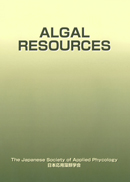In the seedling production method using Solution Extracted from
Homogenized Thalli (SEHT), tissue culture conditions for increasing branch
formation from
Ulva prolifera subfragments have not been
completely optimized yet for land-based cultivation. Thus, we examined the
tissue culture conditions of temperature, nutrients and salinity for
increasing branch formation from
U.
prolifera subfragments
in the seedling production method using SEHT. For temperature, the average
rate of branch formation was 0 % at 5 ℃, 2.8% at 10 °C, increasing to 28.4
% at 15 °C and reached a maximum of 64.0 % at 20 °C. Subsequently, it
decreased to 40.0 % at 25 °C. For nutrients, the average of branch
formation was 67.2 % when PES as nutrients was not added. When PES was
added, the average rate was 72 %, 65.6 %, 65.6 %, 70.4 %, 70.4 %, and 70.8
% at a PES concentration of 0.0125 %, 0.025 %, 0.05%, 0.1% and 0.2 %,
respectively. The average rate of branch formation was almost
constant regardless of the different PES concentrations. For salinity, the
average rate of branch formation was 29.2 to 31.6 % in salinities of 4.8
to 10.6 psu being almost constant, but 38.0 % in salinity of 16.0 psu and
54.0 % in salinity of 27.9 psu indicating increased branch formation in
more saline conditions. In the seedling production method using SEHT, we
recommend culture conditions for increased branch formation of
U.
prolifera subfragments as culturing temperature of 20 ℃, salinity
of 27.9 psu and without adding nutrients.
View full abstract
